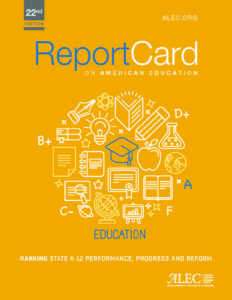Report Card on American Education: 21st Edition
Ranking State K-12 Performance, Progress, and Reform
The future of the American education system has the potential to be bright. In forward-thinking states like Arizona, the state that took the top spot on this year’s ranking, parents are already assembling customized education plans for their children. A student enrolled in Arizona’s education savings account program is able to take math with an award-winning teacher at the local charter school, learn about English literature at home, and purchase access to a professional biology lab to do dissections. He or she can take community college history classes online with the help of a professional tutor twice a week, or take advantage of one-on-one reading therapy on weekends, assuring that challenges are addressed in the sort of individualized way that is impossible in the public school setting.
American students in coming years will not be assessed by how many hours they spend in the classroom, but by how well they have mastered each skill and concept. Learning will take place as quickly or slowly as a student can progress, and being behind in one subject will not jeopardize advancement in another. Graduation will be competency-based, not merely a marker of occupying a classroom seat for 13 years.
This exciting future requires bold state reform that empowers parents, not bureaucrats, and returns control over state dollars to families who know their children best, rather than politicians who have never met them. The states, not the federal government, will be where those much-needed reforms flourish.
The status quo is not working. Whether by international comparisons, state and national proficiency measures, civic literacy rates, or career preparedness, American students are falling behind. Greater and greater numbers of voters – 55 percent in the latest Gallup tracking poll – are dissatisfied with the American education system. And the worn-out response of the entrenched education establishment – “we need more money” – rings hollow after four decades of increased spending with nothing to show in return.
So while the new edition of the Education Report Card grades states across six categories – academic standards, charter schools, homeschool regulation burden, private school choice, teacher quality, and digital learning – two of the factors composing the new education policy grade, charter schools and private school choice, were weighted more heavily because they represent the parent-centered, choice-driven future of education in the 21st century. Our new GPA-based grading and ranking system compares the states based on how their education policies measure up to the demands of that bright future.
While some states have risen to the top of the heap, no state earned higher than a B+ in 2016. There is room to grow; to trust more families instead of regulators, and to ensure that every student has an equal opportunity at the quality, individualized education that 21st-century success requires.


